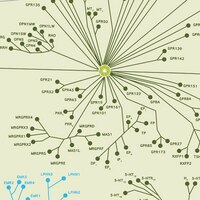Pituitary adenylate cyclase-activating polypeptide and its receptors: from structure to functions.
Vaudry, D, et al.
Pharmacol. Rev., 52: 269-324 (2000)
1999
Mostrar resumen
Pituitary adenylate cyclase-activating polypeptide (PACAP) is a 38-amino acid peptide that was first isolated from ovine hypothalamic extracts on the basis of its ability to stimulate cAMP formation in anterior pituitary cells. PACAP belongs to the vasoactive intestinal polypeptide (VIP)-glucagon-growth hormone releasing factor-secretin superfamily. The sequence of PACAP has been remarkably well conserved during the evolution from protochordate to mammals, suggesting that PACAP is involved in the regulation of important biological functions. PACAP is widely distributed in the brain and peripheral organs, notably in the endocrine pancreas, gonads, and respiratory and urogenital tracts. Characterization of the PACAP precursor has revealed the existence of a PACAP-related peptide whose activity remains unknown. Two types of PACAP binding sites have been characterized. Type I binding sites exhibit a high affinity for PACAP and a much lower affinity for VIP whereas type II binding sites have similar affinity for PACAP and VIP. Molecular cloning of PACAP receptors has shown the existence of three distinct receptor subtypes, the PACAP-specific PAC1 receptor, which is coupled to several transduction systems, and the two PACAP/VIP-indifferent VPAC1 and VPAC2 receptors, which are primarily coupled to adenylyl cyclase. PAC1 receptors are particularly abundant in the brain and pituitary and adrenal glands whereas VPAC receptors are expressed mainly in the lung, liver, and testis. The wide distribution of PACAP and PACAP receptors has led to an explosion of studies aimed at determining the pharmacological effects and biological functions of the peptide. This report reviews the current knowledge concerning the multiple actions of PACAP in the central nervous system and in various peripheral organs including the endocrine glands, the airways, and the cardiovascular and immune systems, as well as the different effects of PACAP on a number of tumor cell types. | 10835102
 |





















